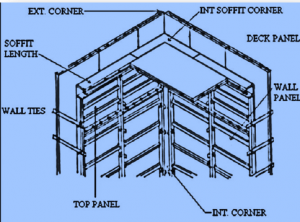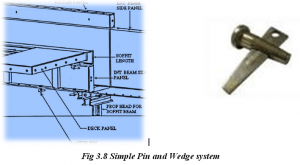How to fix MIVAN aluminium Formwork (Shuttering)
Formwork:
Form work is a mould for a structure. Into this mould, fresh concrete is poured to harden the concrete. The construction of formwork takes time and involves expenditure upto 20 to 25% of the total cost of the structure or even more. Design of these temporary structures are made to economic expenditure. The operation of removing the formwork is known as stripping. Stripped formwork can be reused. Reusable forms are known as panel forms and non-usable are called stationary forms.
Timber is the most common material used for formwork. The disadvantage with timber formwork is that it will warp, swell and shrink. To overcome these issues, MIVAN Formwork came into lame light there are many uses and even profits when compared with the timber formwork.
<script async src="https://pagead2.googlesyndication.com/pagead/js/adsbygoogle.js?client=ca-pub-7854716011105726"
crossorigin="anonymous"></script>
MIVAN ALUMINIUM FORMWORK:
Mivan is an aluminium formwork which is also called as MIVAN Shuttering. This type of formwork is first developed by a European construction company. In 1990, the Mivan Company Ltd. from Malaysia started manufacturing these formwork systems. Today, more than 30,000sqm of formwork from Mivan Co. Ltd. is used across the world. The MIVAN formwork has proven economical as well as satisfactory for the overall construction environment.
Mivan technology is mostly suitable for constructing large number of houses in a short span of time using room size forms to construct walls and slabs in one continuous pour on concrete.
Aluminum formwork is very cost effective for repetitive Building layouts and for above the plinth work. This system is very unique as all the components in a buildings, including slabs, beams, walls, columns, staircases, balconies and special window hood are of concrete and there is no need for block works or brick works.
Parts of MIVAN Formwork:-
It consists of four components Beam components, Deck components and wall components these all are made of high strength aluminium alloy. The modular nature of the Mivan aluminium formwork system allows easy assembling and removal of formwork. The construction can proceed speedily with very little deviation in dimensional tolerances. This System is quite flexible and can be easily adapted for any variations in the layout.

Mivan Aluminium Formwork Assembly:
MIVAN aims in using modern construction techniques and equipment in all its projects. On leaving the MIVAN factory all panels are clearly labeled to ensure that they are easily identifiable on site and can be smoothly assembled together using the formwork modulation drawings.
All formwork begins at a corner and proceeds from there.
Procedure of MIVAN Formwork Construction:
The construction procedure of MIVAN formwork is similar to the traditional type of formwork. The following Process are involved in the MIVAN Construction:
1. Setting up the Wall reinforcing steel:
In this step, the wall reinforcing steel is used to form structure to the building, This reinforcement steel gives support to the concrete till it reaches 50% of designed strength. This steel mesh is Pre-casted in factory itself and can be easily erected on construction site.
2. Placing formwork:
As mentioned, MIVAN formwork is a ready-made one, Formwork is designed and manufactured in factory itself as per the required sizes of slabs, columns, beams, staircase and other structural elements of the buildings. By Pin and wedge system formwork is easily assembled on site. Formwork can be easily dismantled from the structure once the job is done.
3. Pouring concrete:
Once the formwork is placed, Freshly made concrete is poured inside the formwork to form the shape. Once the concrete gains required strength, the formwork is dismantled from the structure.
Simplicity – pin and wedge system in MIVAN aluminium formwork :
The beams are held in position by a simple pin and wedge system that passes through holes in the outside rib of each panel. The panels fit precisely, simply and securely and require no bracing.

Work Cycle of MIVAN Formwork:
Day#1 The first activity consists of erection of vertical reinforcement bars and one side of the vertical formwork for the entire floor or a part of one floor.
Day#2: -The second activity involves erection of the second side of the vertical formwork and formwork for the floor
Day#3: – Fixing reinforcement bars for floor slabs and casting of walls and slabs.
Day#4: -Removal of vertical form work panels after 24hours, leaving the props in place for 7 days and floor slab formwork in place for 2.5 days.
Comparison between MIVAN Formwork and Traditional formwork:-
| MIVAN Formwork | Traditional formwork |
|---|---|
| Ease of construction and easy to remove formwork | Very hard to remove formwork and require more labour to remove formwork |
| Same formwok can be used for 1000 times. | Same Formweork can’t be used more than 10 times. |
| No need of plastering | Need of plastering |
| High seismic resistance | Low seismic resistance |
| Faster in completion of formwork | Takes to time to construct formwork and remove |
Formwork is a mould for a structure. Into this mould, fresh concrete is poured to harden the concrete. The construction of formwork takes time and involves expenditure upto 20 to 25% of the total cost of the structure or even more. Design of these temporary structures are made to economic expenditure. The operation of removing the formwork is known as stripping. Stripped formwork can be reused. Reusable forms are known as panel forms and non-usable are called stationary forms.
Timber is the most common material used for formwork. The disadvantage with timber formwork is that it will warp, swell and shrink. To overcome these issues, MIVAN Formwork came into lame light there are many uses and even profits when compared with the timber formwork.
MIVAN ALUMINIUM FORMWORK:
Mivan is an aluminium formwork which is also called as MIVAN Shuttering. This type of formwork is first developed by a European construction company. In 1990, the Mivan Company Ltd. from Malaysia started manufacturing these formwork systems. Today, more than 30,000sqm of formwork from Mivan Co. Ltd. is used across the world. The MIVAN formwork has proven economical as well as satisfactory for the overall construction environment.
Mivan technology is mostly suitable for constructing large number of houses in a short span of time using room size forms to construct walls and slabs in one continuous pour on concrete.
Aluminum formwork is very cost effective for repetitive Building layouts and for above the plinth work. This system is very unique as all the components in a buildings, including slabs, beams, walls, columns, staircases, balconies and special window hood are of concrete and there is no need for block works or brick works.
Parts of MIVAN Formwork:-
It consists of four components Beam components, Deck components and wall components these all are made of high strength aluminium alloy. The modular nature of the Mivan aluminium formwork system allows easy assembling and removal of formwork. The construction can proceed speedily with very little deviation in dimensional tolerances. This System is quite flexible and can be easily adapted for any variations in the layout.

Mivan Aluminium Formwork Assembly:
MIVAN aims in using modern construction techniques and equipment in all its projects. On leaving the MIVAN factory all panels are clearly labeled to ensure that they are easily identifiable on site and can be smoothly assembled together using the formwork modulation drawings.
All formwork begins at a corner and proceeds from there.
Procedure of MIVAN Formwork Construction:
The construction procedure of MIVAN formwork is similar to the traditional type of formwork. The following Process are involved in the MIVAN Construction:
1. Setting up the Wall reinforcing steel:
In this step, the wall reinforcing steel is used to form structure to the building, This reinforcement steel gives support to the concrete till it reaches 50% of designed strength. This steel mesh is Pre-casted in factory itself and can be easily erected on construction site.
2. Placing formwork:
As mentioned, MIVAN formwork is a ready-made one, Formwork is designed and manufactured in factory itself as per the required sizes of slabs, columns, beams, staircase and other structural elements of the buildings. By Pin and wedge system formwork is easily assembled on site. Formwork can be easily dismantled from the structure once the job is done.
3. Pouring concrete:
Once the formwork is placed, Freshly made concrete is poured inside the formwork to form the shape. Once the concrete gains required strength, the formwork is dismantled from the structure.
Simplicity – pin and wedge system in MIVAN aluminium formwork :
The beams are held in position by a simple pin and wedge system that passes through holes in the outside rib of each panel. The panels fit precisely, simply and securely and require no bracing.

Work Cycle of MIVAN Formwork:
Day#1 The first activity consists of erection of vertical reinforcement bars and one side of the vertical formwork for the entire floor or a part of one floor.
Day#2: -The second activity involves erection of the second side of the vertical formwork and formwork for the floor
Day#3: – Fixing reinforcement bars for floor slabs and casting of walls and slabs.
Day#4: -Removal of vertical form work panels after 24hours, leaving the props in place for 7 days and floor slab formwork in place for 2.5 days.
Comparison between MIVAN Formwork and Traditional formwork:-
| MIVAN Formwork | Traditional formwork |
|---|---|
| Ease of construction and easy to remove formwork | Very hard to remove formwork and require more labour to remove formwork |
| Same formwok can be used for 1000 times. | Same Formweork can’t be used more than 10 times. |
| No need of plastering | Need of plastering |
| High seismic resistance | Low seismic resistance |
| Faster in completion of formwork | Takes to time to construct formwork and removeTechnical Specifications of MIVAN Formwork: |
| Description | Specifications |
|---|---|
| Load carrying Capacity | 7000-8000Kg/Sq.m |
| Sheet Thickness | 4mm |
| Repetitions | 250 times (minimum) |
| Cycles per month | 4-5 times |
| Material used | Aluminium Alloy |
| Cost per Sq.m | 100$ to 120$ per Sqm |

Comments